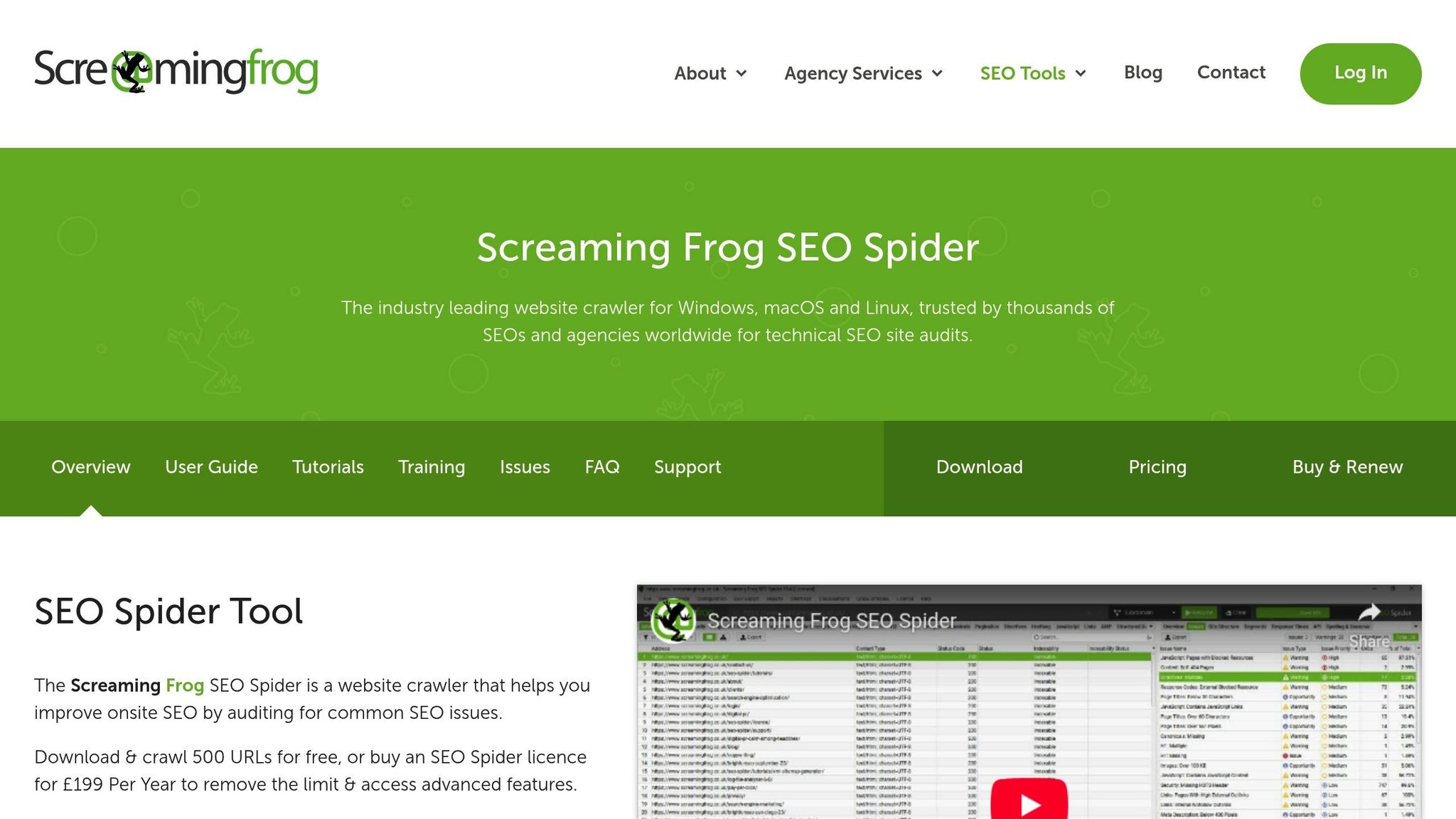Mastering the Technical SEO Audit: Step-by-Step Guide to Boost Your Site’s Performance

Last Updated on 30 September 2025 by Dorian Menard
Technical SEO is the backbone of a website’s performance. A well-executed technical SEO audit ensures your site is fast, mobile-friendly, secure, and easy for search engines to crawl and index. Here’s what you’ll gain:
- Better Visibility: First-page rankings get 75% of clicks.
- Faster Performance: 53% of users leave if a site takes over 3 seconds to load.
- Improved User Experience: 60% of global traffic comes from mobile devices.
- Competitive Edge: Top 3 search results capture 55% of clicks.
Key Audit Areas:
- Crawlability: Ensure search engines can access your content.
- Site Speed: Optimize load times to retain users.
- Mobile Compatibility: Confirm your site works well on all devices.
- Security: Use HTTPS and fix vulnerabilities.
- Structure: Improve navigation and internal linking.
Essential Tools:
- Google Search Console: Tracks crawl stats, indexing, and mobile usability.
- Screaming Frog: Detects broken links, duplicate content, and more.
- PageSpeed Insights: Optimizes load times.
- Schema Testing Tools: Validates structured data for rich results.
By regularly auditing your site, you can fix technical issues, improve rankings, and enhance the user experience. Start now to maintain strong SEO performance.
Screaming Frog SEO Spider Tutorial – How To Do An SEO Audit

Required SEO Audit Tools
To perform a thorough SEO audit, you’ll need tools that help identify and fix website issues. Below are some essential tools to evaluate your site’s technical health.
Using Google’s Core Tools
Google Search Console (GSC) and Google Analytics are must-haves for any technical SEO audit. GSC helps you monitor your site’s performance in search results and spot critical issues.
Here’s what it offers:
| Feature | What It Does | Why It Matters |
|---|---|---|
| Crawl Stats | Tracks how Google crawls your site | Pinpoints server response issues |
| Index Coverage | Monitors indexed pages | Helps resolve indexing problems |
| Mobile Usability | Checks mobile optimization | Ensures proper responsive design |
| Core Web Vitals | Tracks performance metrics | Improves user experience |
“Combine GSC with Screaming Frog for deeper insights for better results.”
Google Analytics complements GSC by providing detailed user data, helping you understand how technical issues affect user experience.
Working with Screaming Frog
Screaming Frog takes your audit to the next level by uncovering issues that basic tools might miss. At $259/year, it offers powerful features, including:
- Crawling and analyzing up to 500 URLs for free
- Detecting broken links and redirect chains
- Auditing meta descriptions and title tags
- Spotting duplicate content
- Analyzing site architecture
One standout feature is its integration with the Google URL Inspection API, allowing analysis of up to 2,000 URLs per property daily. This integration gives a more detailed view of how Google interprets your pages.
Additional SEO Tools
Here are some other tools to consider:
- PageSpeed Insights: Crucial for optimizing site speed, especially since 38% of users leave a website if it takes more than 5 seconds to load.
- Schema Testing Tools: Useful for checking structured data and ensuring rich snippets display correctly in search results.
- SE Ranking: Starting at $65/month, this tool is great for technical audits and excels in local SEO analysis.
For larger websites, advanced platforms offer scalable solutions:
| Tool | Main Function | Starting Price |
|---|---|---|
| Semrush (read review) | Technical SEO Analysis | $139.95/month |
| Ahrefs | Competitor Analysis | Custom pricing |
| Seobility | SEO Analysis – All-in-one tool | Starts at 200$ per month |
| Lumar | Enterprise-level Audits | Custom pricing |
Our team has compared 15 of the main SEO audit tools available on the market in this post!
sbb-itb-c74901f
Main Audit Check Points
Site Crawling and Indexing
Crawling and indexing form the backbone of technical SEO. Start by reviewing your robots.txt file to ensure you’re not accidentally blocking important content. Then, check your sitemap.xml – it helps search engines navigate your site. Make sure the <lastmod> dates are correct since Google uses them to plan its crawls.
Key steps to review:
- Make sure robots.txt doesn’t block critical content.
- Confirm the sitemap includes all key URLs with accurate
<lastmod>dates. - Keep an eye on and fix any 4xx/5xx server errors as soon as possible.
Once that’s done, focus on page speed to ensure your site performs well for both users and search engines.
Page Speed and Performance
Page speed directly affects both rankings and user behavior, even for local websites. For example, a one-second delay in load time can cut conversions by 7%, and every extra second can lead to a 4.42% drop in conversion rates.
| Load Time | Impact |
|---|---|
| 1–5 seconds | Up to 90% of users may leave the site |
| Per second delay | Around 4.42% drop in conversion rates |
| After 5 seconds | Significant traffic loss |
Boost your site’s performance by:
- Using Gzip compression to shrink file sizes by up to 70%.
- Compressing images with tools like TinyPNG while keeping quality intact.
- Reducing HTTP requests by combining CSS/JavaScript files and using CSS sprites.
Mobile and User Experience Tests
With 64% of searches happening on mobile devices, optimizing for mobile users is critical. A poor mobile experience can hurt engagement – half of users are less likely to interact with sites that aren’t mobile-friendly.
Key areas to optimize:
- Set the viewport for proper scaling on mobile devices.
- Ensure touch elements and text are easy to use and read on smaller screens.
- Regularly test your site across different devices to catch any issues.
“While page experience is important, Google still seeks to rank pages with the best information overall, even if the page experience is subpar. Great page experience doesn’t override having great page content. However, in cases where there are many pages that may be similar in relevance, page experience can be much more important for visibility in Search.” – Google
Technical SEO Deep Dive
This section dives into advanced technical fixes, expanding on core audit findings to further improve your site’s performance.
Schema Markup Setup
Schema markup can improve search visibility and boost click-through rates. For example, rich result pages can see up to an 82% higher CTR and 1.5× longer user engagement.
To get started, use Google’s Structured Data Markup Helper to select the appropriate schema type, like Product, Article, FAQ, or schema for Local Business.
For implementation, rely on JSON-LD, a format widely supported by search engines for its ease of use and compatibility.
Website Security Checks
Addressing security issues is essential for both user trust and SEO performance. Focus on these key elements:
| Security Element | Impact on SEO | Implementation Priority |
|---|---|---|
| HTTPS Protocol | Direct ranking factor | High – Immediate action needed |
| Mixed Content | Affects user trust | Medium – Fix within 30 days |
| Malware Protection | Prevents blacklisting | High – Continuous monitoring |
“Security is a top priority for Google…Beyond our own stuff, we’re also working to make the Internet safer more broadly. A big part of that is making sure that websites people access from Google are secure.”
Internal Links and Content
Use insights from tools like Screaming Frog to improve internal linking for better crawl efficiency. Internal links help search engines understand your site structure and distribute link equity effectively. Here’s how to optimize:
- Link related content with descriptive anchor text.
- Build topic clusters to organize content logically.
- Add breadcrumb navigation to strengthen link equity.
- Regularly monitor and fix broken links to maintain link value.
“It will help us understand your pages better, and indirectly, it leads to better ranks in some sense, because we can rank easier.”
– Gary Illyes, Google
Next Steps and Maintenance
Audit Checklist
Create an SEO audit checklist to regularly evaluate and maintain your website’s health:
| Audit Area | Key Elements | Frequency |
|---|---|---|
| Core Technical | Crawling, Indexing, Meta Data | Monthly |
| Performance | Page Speed, Mobile Optimization | Quarterly |
| Security | HTTPS, Mixed Content, Malware | Monthly |
| Content Structure | Internal Links, Schema Markup | Quarterly |
Work closely with your development team to quickly address any issues. As Arthur Camberlein, Senior SEO Specialist at Shopify, advises: “Limit yourself to a maximum of five tools to maintain efficiency and avoid confusion, given that each tool operates on different standards and metrics”.
Once your fixes are in place, use the tools below to monitor your site’s technical health.
Regular Check-up Tools
These tools are trusted by SEO professionals for daily monitoring:
- Google Search Console (G2: 4.7/5, Capterra: 4.8/5) – Offers free, daily insights into your site’s performance.
- Google Analytics (G2: 4.5/5, Capterra: 4.7/5) – Provides detailed traffic analysis.
- Screaming Frog (G2: 4.7/5, Capterra: 4.9/5) – Costs $259/year for full access and is ideal for in-depth audits.
By consistently using these tools alongside your audit checklist, you’ll be able to maintain and improve your site’s performance.
“The Technical SEO Audit is like an assessment of the foundation of a house. You can still live in a house without a great foundation, but eventually cracks will appear. If you don’t take care of your Technical SEO issues early, you might end up reducing the impact of other SEO efforts and limiting your potential growth.” – Rodrigo Lasanta, Lead SEO Specialist
Regular monitoring ensures your SEO strategy stays on track and supports long-term goals.
SEO Impact on Business
Technical SEO plays a key role in business success. Websites ranked in the top three positions using advanced Perth SEO techniques capture about 55% of clicks. To maintain competitive rankings:
- Conduct thorough audits every quarter to uncover issues that automated tools might miss.
- Run automated health checks monthly.
- Schedule immediate audits if you experience sudden drops in traffic or rankings.
If you’re in a highly competitive industry, consider increasing audit frequency to monthly reviews to catch problems early and stay ahead.